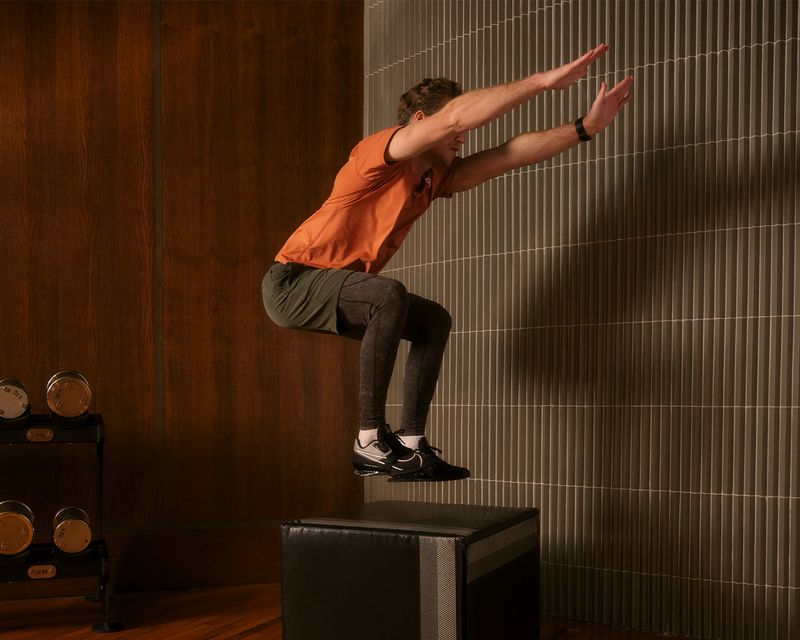THE JOURNAL

Mr Roger Frampton isn’t your typical personal trainer. Serving as the model for this shoot, he was a little out of his comfort zone: he doesn’t run, for example. Or lift weights. Or spend too much time at the gym, really. Instead, he stays in remarkable shape by doing something you probably did when you woke up this morning: stretching.
The thing is, you probably did it wrong. His regimen, the Frampton Method, developed after a wildly successful TEDx Talk titled “Why Sitting Down Destroys You” (which is well on its way to reaching four million views), is suitable for all levels of fitness and aims to improve flexibility, strength and facilitate conscious, natural movement. In short, he aims to get his clients’ bodies to move the way they’re supposed to move, before sitting at a desk all day, every day, trained them otherwise.
Mr Frampton believes that the now-normalised punishing fitness routines and non-stop training schedules adopted by many are not in fact the key to developing greater strength; and, importantly, that they’re inaccessible for most of us with regular nine-to-five jobs.
It’s a refreshing approach and one that resonates at this particular moment. It’s tempting to throw yourself into a rigorous new regimen in the hopes that you’ll be an Adonis by the time January is through, but you’ll see longer, more tangible results if you don’t rush yourself. Here, he shares his tips on how to get back into the swing of things, slowly but surely. The advice is universal, so if you’re already set on cycling, a Hiit plan, or maybe you want to give curling a go, it’ll apply.
01.
Start slow
Yes, it might seem like a tired cliché, but, after the year we’ve all had – including stay-at-home restrictions and gym closures – it’s more relevant than ever. Some of us have used this time to get into the best shape of our lives and others, well, haven’t quite got there. “Obviously, we’re used to a lot more movement, even just with going to work,” says Mr Frampton, speaking of the challenges posed by the pandemic. “Recently, we’ve seen a lot less of that: a lot less people walking to the train station, let alone leaving your front door. Most injuries occur due to being static,” he says. “Anything that’s going to get your body moving in any way. Whether it’s cycling, walking, going for a hike… Any way you can, just get back into it.”

02.
Try just 10 minutes
If you’re feeling particularly unmotivated, Mr Frampton advises doing what you can to reduce the pressure on yourself to get an hour-long session in the bag. “My whole method is based on just 10 minutes a day. I’m all about consistency… It’s a marathon, not a sprint,” he explains. Getting over that mental block is your biggest obstacle to getting back into the swing of things. Not only will shorter periods of exercise reduce the risk of injury, it’ll help you to establish a routine you’re less likely to give up on. “It becomes more of a habit. It becomes like brushing your teeth. It’s something that you get into the groove of and you do whether you’re tired or not. Little and often is the key when it comes to training. Then it doesn’t become overwhelming.”

03.
Set micro-goals
Think you’ll be marathon-ready by the end of January when you’ve barely started training? That’s a surefire way to set yourself up for disappointment, or worse, injury. Instead, build progress in small, rewardable chunks. “It’s good to have micro-goals, little things that you’re working on completing. That can be within the same area [of fitness or activity],” Mr Frampton says. You can make them as simple or intricate as you like, too. “Take walking for example,” he says. “If you’re bored with your walks, try to complete your walk in a faster time. Give it more variables: try to walk uphill, try to mix up what you’re doing even if it’s the same exercise.”

04.
Move (the right way)
Traditional wisdom suggests that building your core is the key to beating your personal best, but Mr Frampton says we’re getting ahead of ourselves. “Coming from a gymnastics background, we don’t do a lot of core training. Rather, we’re really focused on the joints of the body; how to get the joints of the body moving in all directions,” he explains. In fact, we’ve all been moving the wrong way our whole lives. “[You have to] get your shoulders moving how your shoulder has evolved to move. Get your hips moving how your hips have evolved to move. Through years of sitting down and being static, these joints get stuck and tight. Weight training and too much emphasis on core training can just add to the problem. Instead try stretching, loosening up, reopening up the body and undoing tight areas.” Get it right and core strength will naturally follow.

05.
Go back to school
The real secret to building and maintaining a varied and enjoyable fitness plan is to think of training as a teaching experience, rather than approaching it as a chore. “If you treat exercise like learning a skill, it’s much easier to stick to it,” Mr Frampton says. He throws out studying a new swimming stroke or swotting up on proper boxing form, as just two suggestions for how to trick your body into working harder. “Humans are great at learning,” he says. “We do that at school and children perform best when they’re learning skills. If you’re always learning something, you’ll say, ‘Oh, yeah, I did it.’ It’s those little rewards that keep you going.” And, after all, we’re all just big kids at heart.